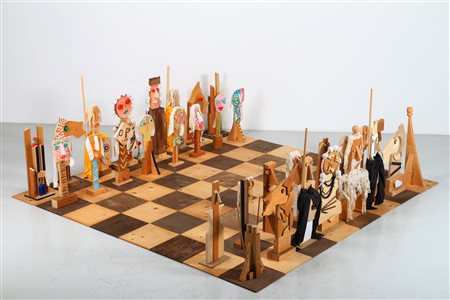 Capitolium Art - Via Carlo Cattaneo 55, 25121 Brescia
Capitolium Art - Via Carlo Cattaneo 55, 25121 Brescia
ASTA 258 ARTE MODERNA E CONTEMPORANEA I Tornata 1-70
Tuesday 9 April 2019 hours 16:00 (UTC +01:00)
BAJ ENRICO (1924 - 2003) Il gioco degli scacchi. . 1988. Legno. Cm 272,00 x...
BAJ ENRICO (1924 - 2003) Il gioco degli scacchi. . 1988. Legno. Cm 272,00 x 75,00 x 272,00. Edizione completa: 30 + V. Esemplare: 12. Mastrogiacomo Edizioni - Padova. L'opera è costituita da 32 sculture (la cui altezza media è di 75 cm) ognuna diversa dall'altra, eseguite completamente a mano su prototipo dell'artista e 32 tavolette da accostare su un piano o sul pavimento in modo da creare una scacchiera. Il materiale principalmente usato è il legno e, visto l'ingombro della scacchiera è possibile esporre i pezzi su una scaffalatura a tre ripiani simile a una libreria occupando a parete uno spazio di 2,50 metri in altezza per 2,50 metri in larghezza per 25 cm di profondità. Le tavolette di 34x34 cm possono essere raccolte e impilate. Ogni pezzo reca un sigillo e la numerazione a mano. Autentica su fotografia firmata dall'artista e con sigillo dell'editore. L'opera è accompagnata dal libro "Gli Scacchi di Baj", Mastrogiacomo Edizioni - Padova, con introduzione di Pietro Bellasi e testi di Olivier Revault d'Allones.
BAJ ENRICO (1924 - 2003) . 1988. Wood. Cm 272,00 x 75,00 x 272,00. 12/30 + V. The work consists of 32 sculptures (whose average height is 75 cm) each different from the other, executed entirely by hand on the artist's prototype and 32 tablets to be placed on a shelf or on the floor in order to create a chessboard . The material mainly used is wood and, given the size of the chessboard, it is possible to expose the pieces on a three-shelf shelving similar to a bookcase occupying a space of 2.50 meters in height and 2.50 meters in width per wall. 25 cm deep. The 34x34 cm tablets can be collected and stacked. Each piece bears a seal and hand numbering. Authentication on photograph signed by the artist and with the publisher's seal. The work is accompanied by the book "Gli Scacchi di Baj", Mastrogiacomo Edizioni - Padova, with an introduction by Pietro Bellasi and texts by Olivier Revault d'Allones.









